Did you know there’s actually a National Goldie Day? I had no idea until several years ago when I was scrolling through my Instagram and saw many posts celebrating these golden cinnamon rolls. While we should honor all pets every day, Golden Retrievers have a special place for many Americans, and perhaps for people all over the world.
If you are the proud owner of a Goldie, you might wonder how big your fur baby can grow at some points. That’s when our Golden Retriever growth chart comes in handy! Let’s walk you through various stages of their development and the factors that influence them!
Female and Male Golden Retriever Growth Chart
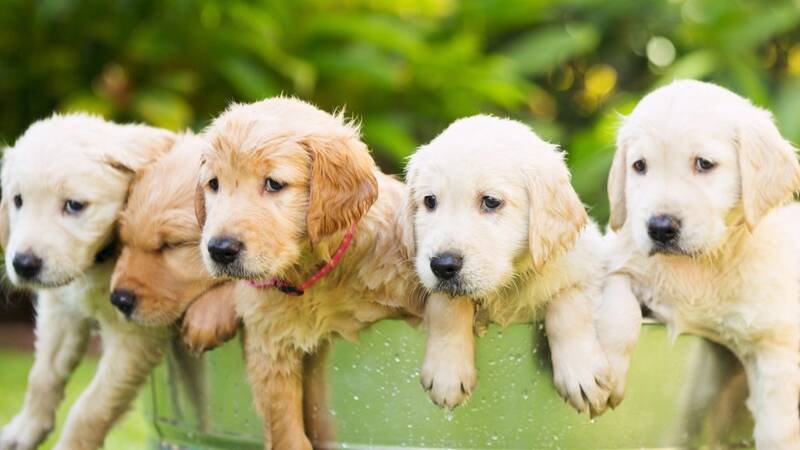
Golden Retrievers undergo significant growth during their first year, with males typically reaching a larger size than females. Here’s a breakdown of their growth phases:
Newborn to 8-week stage
In this important early phase, Golden Retriever puppies experience significant growth:
- At birth, they weigh between 14 and 16 ounces.
- By the end of the first week, their weight doubles.
- During weeks 2 to 3, their eyes open and their first teeth emerge.
- In weeks 4 to 5, they start the weaning process.
- By weeks 6 to 8, their weight varies from 5 to 10 pounds.
2 to 6 months stage
During this phase, there are notable growth spurts, as shown in the Golden Retriever height chart:
| Age (months) | Female Weight (lbs) | Male Weight (lbs) |
| 2 | 10-15 | 11-17 |
| 3 | 22-30 | 24-34 |
| 4 | 30-40 | 35-45 |
| 5 | 40-50 | 45-55 |
| 6 | 45-55 | 50-65 |
6 to 12 months stage
Growth starts to decelerate but remains consistent:
| Age (months) | Female Weight (lbs) | Male Weight (lbs) |
| 7 | 50-60 | 55-70 |
| 8 | 55-65 | 60-75 |
| 9 | 60-70 | 65-80 |
| 10 | 60-70 | 65-80 |
| 11 | 60-70 | 65-80 |
| 12 | 60-70 | 65-80 |
Adult stage (after 12 months)
By the time they are 12 to 18 months old, most Golden Retrievers attain their full adult size:
- Females typically weigh between 55 and 70 pounds and stand 21.5 to 22.5 inches tall.
- Males generally weigh between 65 and 75 pounds and measure 23 to 24 inches in height.
Keep in mind that individual dogs may differ from these averages due to several factors.
Factors Affecting Golden Retriever Growth
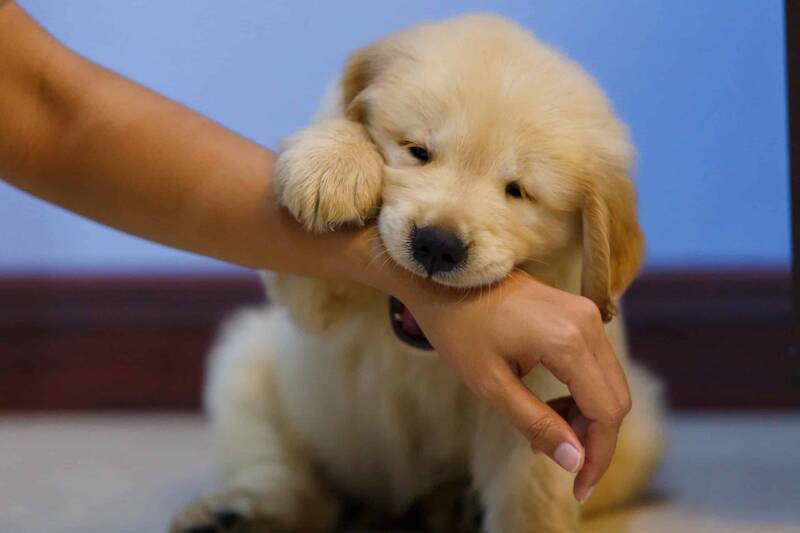
While we just outlined the general growth stages, many outside factors can influence when our Golden Retrievers stop growing. Keep these in mind as you track your fur baby’s development:
Diet
For those working in the pet care industry, the ideal world is one where all Goldies get the best food for Golden Retrievers puppies at a young age. Nutritious diets help puppies reach their adulthood on time without any problems. Unfortunately, some Golden Retrievers are malnourished, resulting in low body weights and slowed development.
“Golden Retriever puppies suffering from malnutrition lack proteins, minerals, vitamins, and calories required for healthy growth,” explains veterinarian Jamie Whittenburg from Kingsgate Animal Hospital. “These dogs might not grow to the size potential for their breed.”
At the puppy stage, every dog requires the right balance of nutrients to support their development. Thus, make sure you don’t restrict calories to slow down your pet’s growth. Calorie restriction doesn’t result in a smaller version of Golden Retriever, but a mix of health conditions and illnesses.
Neutering/Spaying Time
There are too many myths surrounding when to neuter or spay Golden Retrievers. Some say the procedure stops puppies from growing, while others claim the opposite. Which one is true, then?
According to Dr. Whittenburg, research shows that during the development phase, sex hormones will seal the canine growth plates. By spaying or neutering, you eliminate these hormones, allowing the growth plates to remain open longer.
Thus, performing the procedures before your Golden Retriever reaches the 8th month of age will allow them to grow a bit larger than their canine friends.
Gender
Male Golden Retrievers often grow slightly bigger than their female counterparts. Additionally, males’ backbones also develop a bit longer.
While the differences in size are not significant, knowing that your male and female dogs will peak at various weights in various months is crucial if you have a mixed litter.
Genetic Influence
Like any dog breed, the final size of your Golden Retriever is influenced by their genes. If you want to understand the development rate of your pup, as well as their potential height and weight, take a look at their parents.
Health Conditions
From newborn to 6 months, puppies grow at a rapid rate. Thus, you can easily notice if your Goldie isn’t growing at all. Many serious health conditions can have bad impacts on their development stages, such as:
- Intestinal parasites: Veterinarians point out that parasites like roundworms may cling to dogs’ intestines and consume nutrients there. The result is nutritional deficits and stunted development. This condition is prevalent in Golden Retrievers, with symptoms like diarrhea, dry coat, bloating, and vomiting.
- Portosystemic shunts: This occurs when a liver’s vessels circumvent the liver’s regular blood flow. As a result, blood travels from the smaller intestines straight to the dog’s body, and nutrients are not absorbed. Depending on the severity of portosystemic shunts, this lack of nutrition may slow down your dog’s growth. Signs of the condition include weight loss, diarrhea, vomiting, and medication sensitivity.
- Osteochondritis dissecans (OCD): A condition that occurs in dogs that grow too quickly. The root cause of this is an excess cartilage pocket, which grows, breaks away and becomes stuck. These pockets are typically seen on the shoulders. The condition makes it painful for your Goldie even to move. Male dogs from big breeds like Golden Retrievers are more prone to OCD, and if the condition worsens, surgery might be required.
At What Age is a Golden Retriever Fully Grown?
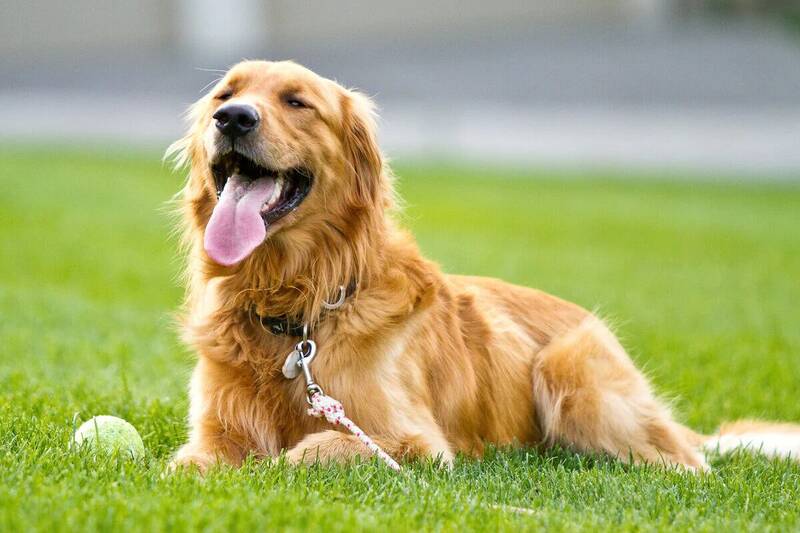
Golden Retrievers usually achieve their maximum height by the age of 12 months. Nonetheless, they may keep developing and gaining muscle until they are between 18 to 24 months old. Males generally take a bit longer to reach their full size than females do.
Estimating the adult size of a Golden Retriever can be difficult, but there are some helpful indicators:
- Paw dimensions: Bigger paws typically suggest a larger adult size.
- Size of the parents: Puppies usually reach a size comparable to that of their parents.
- Growth speed: A fast growth rate in the early stages may signal a larger adult size.
- Weight at 16 weeks: Doubling this weight can provide an estimate for adult weight.
Keep in mind that these are just approximations, and individual dogs may differ.
Appropriate Nutrition for Each Growth Stage
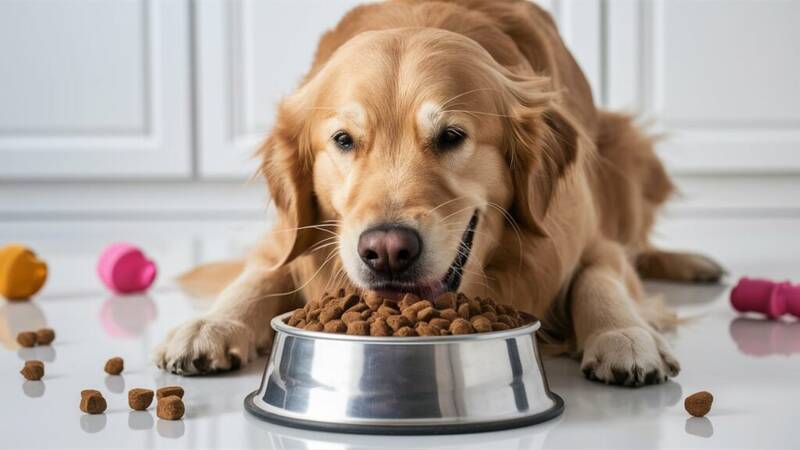
Adequate nutrition is essential for the healthy development of Golden Retrievers.
Nutrition for Golden Retriever Puppies (0-6 months):
- Food type: It is crucial to choose premium puppy food designed specifically for large breeds.
- Protein content: Target a protein percentage of 22-24% to aid in swift growth and development.
- Fat content: Maintain a fat level of approximately 12-15% to supply the energy needed for energetic puppies.
Nutrition for Adolescent Golden Retrievers (6-12 months):
- Transitioning: Slowly introduce adult dog food during this period.
- Protein Content: Aim for a protein level between 21-23% to support muscle growth.
- Fat Content: The fat content should be approximately 12-14%.
- Calorie Monitoring: Monitor calorie consumption to avoid obesity, which can be an issue during this developmental stage.
Nutrition for Adult Golden Retrievers (after 12 months):
- Food Type: Offer premium adult dog food to fulfill their continuous nutritional requirements.
- Protein Content: Target a protein percentage of 18-22% to promote overall well-being.
- Fat Content: Maintain fat levels between 10-12%.
- Portion Control: Modify food servings according to your dog’s activity level and body condition to help them stay at a healthy weight.
Modify portions based on activity level and body condition.
Caring for Golden Retrievers During the Growth Process
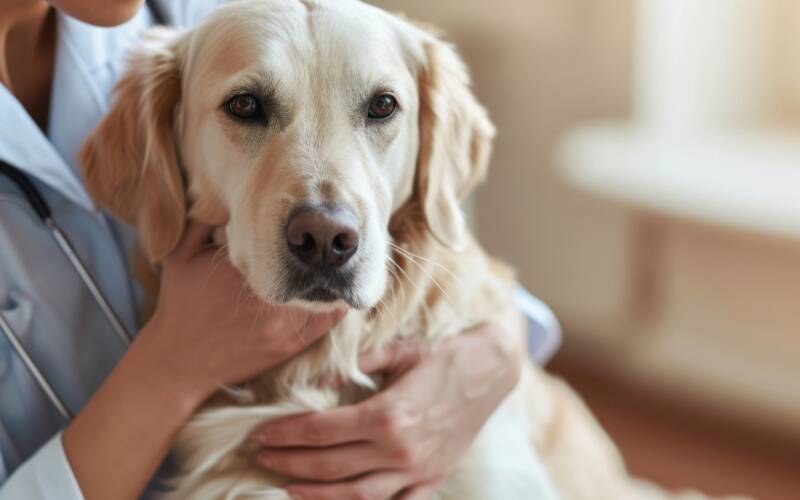
Adequate care during the developmental phases is crucial for ensuring a healthy adult dog.
Appropriate Exercise Regimen
- Puppies: Participate in short, frequent play sessions to encourage social skills and physical growth. Try to have multiple brief interactions each day to keep them active without overwhelming them.
- Adolescents: Slowly extend the length and intensity of exercise as they mature. This phase is crucial for developing strength and stamina, so include longer walks and more engaging play activities.
- Adults: Aim for 1-2 hours of daily exercise to sustain their physical health and mental engagement. Activities can consist of walking, running, swimming, and playtime to ensure they remain fit and content.
Health Care and Vaccinations
Adhere to a vaccination schedule recommended by your veterinarian:
- 6-8 Weeks: Give the initial DHPP vaccine, which guards against distemper, hepatitis, parainfluenza, and parvovirus.
- 10-12 Weeks: Administer the second DHPP vaccine along with the first Rabies vaccine to boost immunity.
- 14-16 Weeks: Provide the third DHPP vaccine for ongoing protection.
- 1 Year: Arrange booster shots for both the DHPP and Rabies vaccines to sustain immunity.
Consistent check-ups and preventive care are essential during all stages of growth.
Basic Training
Start training early to develop good habits. Teach essential commands for obedience and safety:
- Sit: To teach your puppy to sit on command, hold a treat above their nose and move it back over their head. Reward them immediately when they sit.
- Stay: After your puppy learns to sit, train them to stay by asking them to sit and gradually stepping away. Reward them for remaining in place.
- Come: Begin with a long leash to encourage your puppy to come to you. Call their name followed by “come” and reward them when they arrive.
- Down: To teach “down,” start with your puppy sitting and slowly lower a treat from their nose to the ground. Reward them when they lower themselves to get the treat.
Also, use treats and praise to reward desired behaviors. This method fosters a positive association with training, motivating your puppy to repeat good behaviors.
Conclusion
Nurturing a Golden Retriever is a fulfilling journey that demands attention to their physical maturation. Monitoring their development patterns and referencing a Golden Retriever Growth Chart can provide valuable insights. When combined with proper nutrition and attentive care, this approach can help your Golden Retriever flourish into a robust and content adult canine. It’s crucial to remember that each dog has its unique growth trajectory; while Golden Retriever Growth Charts offer helpful benchmarks, your veterinarian remains the most dependable resource for personalized advice on your pet’s development and overall health. By utilizing these tools and professional guidance, you can effectively support your Golden Retriever through its various growth stages.

As a professional writer who specializes in canine care, I have spent a significant amount of time researching and writing about Golden Retrievers. While I do not own a Golden Retriever, my considerable research and collaboration with doctors, breeders, and Golden Retriever experts has provided me with a lot of information about this incredible breed. My writing covers a wide range of topics, from food and health concerns to behavior and training, to assist owners in raising well-rounded, healthy golden retrievers. Through this website, I wish to share my knowledge and positively touch the lives of both dogs and their humans.
